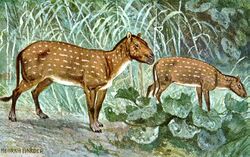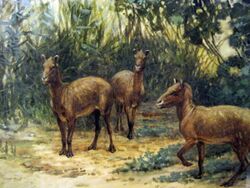Biology:Eohippus
| Eohippus | |
|---|---|

| |
| Restoration by Heinrich Harder c. 1920 | |
| Scientific classification | |
| Script error: No such module "Taxobox ranks".: | Animalia |
| Script error: No such module "Taxobox ranks".: | Chordata |
| Script error: No such module "Taxobox ranks".: | Mammalia |
| Script error: No such module "Taxobox ranks".: | Perissodactyla |
| Script error: No such module "Taxobox ranks".: | Equidae |
| Script error: No such module "Taxobox ranks".: | †Eohippus Marsh, 1876 |
| Script error: No such module "Taxobox ranks".: | <div style="display:inline" class="script error: no such module "taxobox ranks".">†E. angustidens |
| Binomial name | |
| †Eohippus angustidens (Cope, 1875)
| |
| Synonyms | |
| |
Eohippus is an extinct genus of small equid ungulates.[1] The only species is E. angustidens, which was long considered a species of Hyracotherium. Its remains have been identified in North America and date to the Early Eocene (Ypresian) stage.[2]
Discovery

In 1876, Othniel C. Marsh described a skeleton as Eohippus validus, from Greek: ἠώς (eōs, 'dawn') and ἵππος (hippos, 'horse'), meaning 'dawn horse'. Its similarities with fossils described by Richard Owen were formally pointed out in a 1932 paper by Clive Forster Cooper. E. validus was moved to the genus Hyracotherium, which had priority as the name for the genus, with Eohippus becoming a junior synonym of that genus. Hyracotherium was recently found to be a paraphyletic group of species, and the genus now includes only H. leporinum. E. validus was found to be identical to an earlier-named species, Hyracotherium angustidens (Cope, 1875), and the resulting binomial is thus Eohippus angustidens.
Stephen Jay Gould comments
In his 1991 essay, "The Case of the Creeping Fox Terrier Clone",[3] Stephen Jay Gould lamented the prevalence of a much-repeated phrase to indicate Eohippus size ("the size of a small Fox Terrier"), even though most readers would be quite unfamiliar with that breed of dog. He concluded that the phrase had its origin in a widely-distributed pamphlet by Henry Fairfield Osborn, and proposed that Osborn, a keen fox hunter, could have made a natural association between his horses and the dogs that accompanied them.[3] Eohippus was approximately 12 in (30 cm) high at the shoulder,[4] comparable to a Fox Terrier, which is up to 13 in (33 cm) high at the shoulder.[5]
See also
References
- ↑ MacFadden, B. J. (18 March 2005). "Fossil Horses--Evidence for Evolution". Science 307 (5716): 1728–1730. doi:10.1126/science.1105458. PMID 15774746.
- ↑ Froehlich, D. J. (2002). "Quo vadis eohippus? The systematics and taxonomy of the early Eocene equids (Perissodactyla)". Zoological Journal of the Linnean Society 134 (2): 141–256. doi:10.1046/j.1096-3642.2002.00005.x.
- ↑ 3.0 3.1 Gould, S. J. (1991). "Essay 10: The case of the creeping fox terrier clone". Bully for Brontosaurus: Reflections in Natural History. W.W. Norton & Co.. ISBN 978-0-393-02961-1.
- ↑ "Hyrocotherium (Eohippus)". https://www.equineguelph.ca/equimania/EvolutionTimeline/eohippus.html.
- ↑ "Fox Terrier (Vital Stats)". https://dogtime.com/dog-breeds/fox-terrier#/slide/1.
Wikidata ☰ Q5241216 entry
